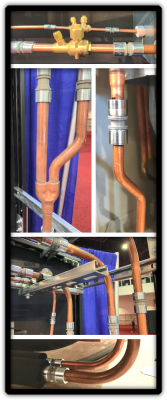Galvanic Corrosion and MTBF / MTTR

TUFFLOK’s various mechanically attached ACR fittings Galvanic Corrosion Analysis and Prevention
SUMMARY
This paper examines galvanic corrosion’s impact on TUFFLOK’s mechanically attached refrigerant fittings, focusing on long-term connection integrity. Galvanic corrosion arises when dissimilar metals are in contact with an electrolyte, like atmospheric moisture, especially in coastal or industrial areas. To mitigate this, active stainless steel 304 or steel with the electroplated epoxy coating is used in couplers and adapters, resulting in a galvanic voltage difference of about 0.2 V. While the stainless steel may rust, self-passivation forms a protective layer. The copper tubing remains unaffected mainly due to its greater surface area; for alloy steel, an electroplated epoxy 25-micron layer is applied to prevent metal-to-metal contact to minimize galvanic action. Proper pipe and coupler insulation minimizes the egress of external moisture that creates electrolytes, ensuring durable connections throughout the (Air Conditioning & Refrigeration) ACR system’s lifespan.
DISCUSSION
In this review, we discuss the effect of galvanic corrosion (GC) on TUFFLOK stainless steel and alloy series refrigerant fittings and the concerns of deterioration over time to the connection strength and seal.
Concern:
GC occurs when dissimilar metals are in contact with each other and when an electrolyte like water is present with dissolved electrolytes like salt. Pure water is not an issue in ACR systems, but the contaminated moisture in the atmosphere acts as an electrolyte when it comes into contact with refrigerant piping and couplers. This is especially true in coastal and industrial areas, where moisture may contain electrolyte chemicals, increasing water conductivity.
Solution:
Stainless steel: We use active stainless steel in our couplers and adapters to minimize the effect of GC. Stainless steel 304 (active) was chosen for its strength and its position on the chart of noble metals. It is less noble (more anodic) than copper.
In an uncontrolled environment, the target galvanic voltage is less than 0.25V. The galvanic voltage difference between copper and active stainless steel 304 in seawater is about 0.2V.
Since active stainless steel is less noble than copper tubing, which has a much greater surface area, the connectors may degrade over the years. Still, the copper tubing remains intact or has minimal and acceptable corrosion.
Additionally, the active stainless steel undergoes a process known as self-passivation. Stainless steel exposed to oxygen forms a thin protective layer of chromium oxide on its surface. This layer is a barrier to the environment, further protecting the stainless steel.
Steel Aloy: Steel alloy couplers coated with an electroplated epoxy layer. They do not come into direct contact with the copper pipe. Even if the portion of the coupler comes into direct contact with the outside of the pipe, there is no danger to the copper pipe, and the thickness of the coupler ensures long-term uninterrupted performance.
Exposure:
The surface area of stainless steel and copper that may come into contact with moisture is only along the circumference of the copper tubing at the coupler joint. There is no entryway for moisture to penetrate under the coupler. The connection prevents refrigerant under pressure from escaping, preventing external moisture from entering. The only exposure is at the steel/copper outer seam.
Protection:
Moisture that collects on piping components inside buildings has a relatively low level of conductivity. However, condensation in outdoor coastal or industrial locations may be very conductive. That is why it is critical for outdoor piping, especially in coastal areas, to be protected from the environment.
Conclusion:
The use of active stainless steel on copper provides excellent protection. Where the stainless steel joints may have some corrosion, the corrosion does not affect the strength of the coupler and offers further protection lasting for many years. For steel alloy couplers, the issue of galvanic deterioration is even less prevalent as the electroplated epoxy coating eliminates direct contact between alloy and copper.
Continuous Innovation: TUFFLOK is committed to addressing evolving field needs and continuously developing new products to meet industry demands, no matter how big or small the task.